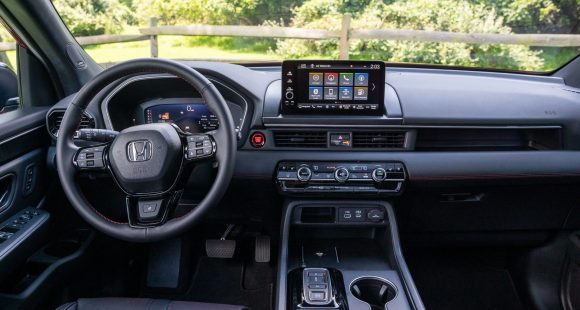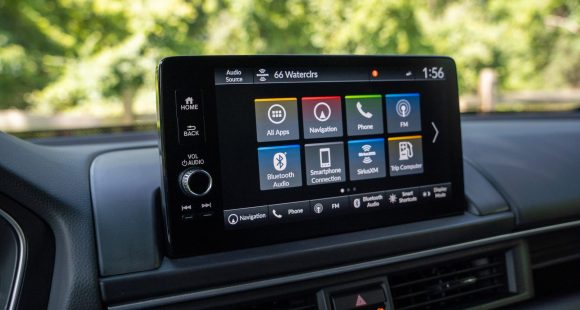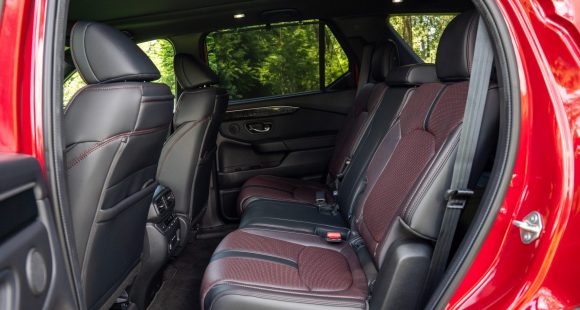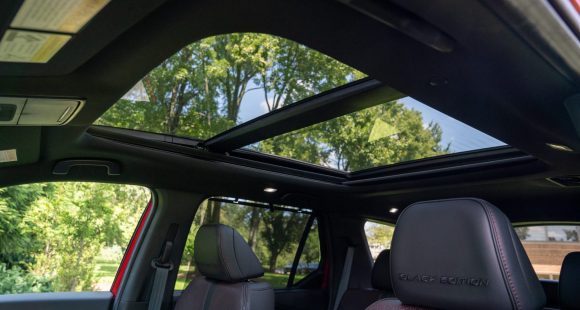2015 Honda Fit
Honda’s American heritage of selling small, roomy, fuel efficient cars, that last for almost forever, is well known. Right from the first civic forty years ago, Honda’s subcompact and compact cars have always provided more in less. But, today, it’s the Honda Fit that carries the banner of maximizing everything but its shadow. And, while the all-new 3rd generation has changed a lot, it’s more “fit” than ever.
We’ve always considered the Honda fit to be a small car that thought outside the traditional subcompact box. Its five-door shell surrounds an unusually airy interior that has proven to be as versatile as a small utility. Plus, driving the fit was not only economical but fun. An attribute most rivals lack.
Well, that formula is more than intact with the all-new third generation fit. In fact we’ll say the 2015 fit actually expands on itself.
 That “moreness” starts with additional power. There’s still a 1.5-liter i4 in place, but it’s a new direct injected mill with 130 horsepower, 13 more than before. Torque is cranked up 8 to 114 lb-ft. It joins the Honda “earth dreams” lineup with updated transmissions. The standard manual is now a 6-speed and the automatic is now a CVT.
That “moreness” starts with additional power. There’s still a 1.5-liter i4 in place, but it’s a new direct injected mill with 130 horsepower, 13 more than before. Torque is cranked up 8 to 114 lb-ft. It joins the Honda “earth dreams” lineup with updated transmissions. The standard manual is now a 6-speed and the automatic is now a CVT.
That dream is realized in better fuel economy at 33-city, 41-highway, and 36–combined for the CVT, tops for its interior size.
This hatchback’s exterior theme remains the same, but the shape has been hit heavily with a buffer. It’s smoother with more sculpting to the up-sweeping bodysides, giving an overall sleeker, more dynamic look.
As for its shadow, there’s more wheelbase and width, but overall length is actually less by an inch and a half. The rear now sports a thick, full width chrome strip connecting the led tail lights; with red reflectors up both sides of the back glass to a hatch-top spoiler. A very aggressive looking rear bumper lies below. Standard, are 15-inch wheels; ex riding on 16s.
While that’s unchanged, the fit’s “more fun-to-drive than it should be” quotient actually grows. The unibody adds rigidity, and while the basic front strut and rear trailing arm suspension design remains, it has been totally reworked with updated components and geometry. Along with more precise handling, ride comfort also takes a turn for the better.
 Honda claims a big improvement in overall driving refinement. And, after our initial drive at Honda’s press launch in San Diego, California, we concur. Except for maybe the new CVT transmission. Unlike the CVT in the accord, which operates pretty quietly, in the fit is just makes for a lot “more” noise as you move up to speed.
Honda claims a big improvement in overall driving refinement. And, after our initial drive at Honda’s press launch in San Diego, California, we concur. Except for maybe the new CVT transmission. Unlike the CVT in the accord, which operates pretty quietly, in the fit is just makes for a lot “more” noise as you move up to speed.
On the other hand, we found the 6-speed manual a great improvement, with short throws and a sporty feel.
But, the biggest uptick in the new fit is the additional interior room. While you do get a sense of it up front, it’s really apparent in the rear. A 1.2-inch gain in wheelbase expands to over 4-inches more leg room, with additional headroom. You have to sit in it to believe it.
The fit’s signature, multi-folding magic seat remains. It has always been one of our favorite fit features, allowing for some unique storage and seating options.
But, something had to give. The added legroom does cut cargo space by 20% to 16.6 cubic feet when all seats are filled. Still, seats flat, fit’s max cargo room of 52.7 is hard to beat with anything that’s not a crossover.
A 3-dial gauge setup carries over, but the center speedometer is larger and all information is presented more clearly.
 Though the interior presentation is still monochromatic and not overly inviting, there’s plenty more when it comes to standard features, with a multi-view back-up camera and bluetooth included. And definitely more luxury and safety options with lane watch, 7-inch display audio and push-button start all available. You can even get your new fit with leather!
Though the interior presentation is still monochromatic and not overly inviting, there’s plenty more when it comes to standard features, with a multi-view back-up camera and bluetooth included. And definitely more luxury and safety options with lane watch, 7-inch display audio and push-button start all available. You can even get your new fit with leather!
Hondalink allows for even more smart-phone integration, and you do it more seamlessly. Iphone users can even talk to Siri. But we’ll need a little more time with it to see how much better it truly is. As before, analog controls are large, logically placed, and easy to use.
Much was publicized about the previous generation Fit’s “poor” IIHS score due to the new small overlap frontal crash test. Well, Honda took that as seriously as potential buyers and expects this fit’s new ace body structure with additional high strength steel to “ace” that test without a problem.
Honda has made significant investments in the new Fit, bringing assembly to North America at a brand new plant in Mexico. But, even with that expenditure they’ve contained base prices. It’s barely increased to $16,355 for a manual. The top-line EX-L Navi goes for $21,630.
The 2015 Honda Fit is indeed more “fit”, and will truly “fit” into many more lifestyles. It provides great versatility and practicality, along with a surprising splash of fun, and now even more so. And, aside from that loud CVT, the 2015 Honda Fit has the “fit”ting formula for even more success.
Specifications
- Engine: 1.5-liter
- Horsepower: 130
- Torque: 114 lb-ft.
- EPA: 33 mpg city/ 41 mpg highway
2024 Toyota Land Cruiser
Toyota’s Go Anywhere Globetrotter Returns To U.S.
Every once in a while, we all need a reset. A time to get back to basics and prioritize the things that really matter. Well, for the Toyota Land Cruiser that time is now. So, let’s find out if that means bigger and better things for Toyota’s iconic off-roader.
The Toyota Land Cruiser’s status among the global off-road community is legendary, and it’s hard to imagine there’s any corner of the earth where a Land Cruiser hasn’t kicked up a little dust or mud. Well, 2024 sees the return of the Land Cruiser to the U.S. market after a 3-year hiatus, getting a major reset for the journey.
The reset comes mostly by no longer being based on the large three-row “300-series” chassis, but a new version of the smaller “200-series,” now known as the J250. As with the latest Tacoma, it uses the Tundra pickup’s full-size steel frame.
While the main Land Cruiser model, which goes by simply Land Cruiser, is packed full of luxury and convenience features, there is also a stripped-down model known as the 1958, honoring the first year the Land Cruiser made landfall here in North America. And it is that 1958 we have here, and we were glad to see it, as it also celebrates the original’s back-to-basics approach as a blank canvas for you to personalize as you tackle more and more adventures.
Not that it’s fully stripped down, as 8-inch touchscreen infotainment, a 7-inch full-color multi-information display, and automatic climate control are still standard. Plus, some seriously durable materials, and great heated cloth front seats that throw off some get serious 1990s Tacoma vibes.
But outside, there’s a definite lack of flashy trim and basic looking 18-inch wheels with Yokohama Geolander all-season tires; plus, big chunky bumpers and tilt-up back glass, which is a rarity that we appreciate. Though there is a little too much plastic in places that are sure to see some abuse if you do any significant off-roading.
It even feels a little rough around the edges, but for us it just adds to the rugged old-school utility vibe in a good way.
We did just that, both here in the Mid-Atlantic as well as in the California desert; and while there are some tech-forward driving aids, the actual hardware is in most cases plenty to get things done. That includes standard full-time dual-range four-wheel-drive, locking center and rear diffs, and 8.7-inches of ground clearance. A front stabilizer bar disconnect is also available to allow for increased articulation.
Who needs a V6 or even a V8 when you’ve got Toyota’s i-FORCE MAX setup at your disposal with 326 horsepower and 465 lb-ft of torque coming from a 2.4-liter turbo-four with an electric motor sandwiched between the engine and its eight-speed automatic transmission. Low speed torque delivery is impressive. It even feels a little rough around the edges, which may be a turn off to some, but for us it just adds to the rugged old-school utility vibe in a good way.
And it certainly feels quicker than an off roader needs to be, with an instant torque dump as soon as we eased on the throttle at our Mason Dixon test track; helping us get to 60 in 8.1 seconds and through the quarter-mile in 16.3 seconds at 86 mph. Considering the Land Cruiser’s terrain conquering mission, it behaved quite well in our handling course; it was plenty responsive to inputs, with less body roll than we expected and plenty of grip from the tires. The steering was light and quick but as expected didn’t provide much feel. Other than significant nosedive, braking performance was exceptional. Only 107-feet to panic stop us from 60 mph.
With the shift to the smaller size, there’s no more third row available, and cargo capacity now comes in at 46.2 cubic-feet with a max of a still healthy 82.1. Now, the best part of the Land Cruiser’s return is the entry price of $57,445. That’s about 30-grand less than what the last Land Cruiser went for back in 2021.
Whether it’s over the top fashion trends, mullets, or zombies; just when you think they’re dead, they come roaring back to life. Of course, we’re much happier to see the resurrection of this 2024 Toyota Land Cruiser than any of those things. Toyota is one brand that still recognizes the value of full-framed rugged rigs and has also acknowledged that sometimes less really is more. The Godfather of Toyota off-roading is back and better than ever.
2025 Honda Pilot Black Edition
Honda’s Most Elite Pilot Gets More Elite
Honda began their Pilot crossover program back in 2003, and it didn’t take long to see that this three-row ute was ready for prime time. Now in its 4th-generation, Honda has created the most off-road capable Pilot yet, but this year, they focus on another set of enthusiasts. Time for us to shine a line on this new Black Edition.
Honda has certainly been an elite performer in the SUV world since their CR-V first hit the pavement in the late 1990s. So much so, they’ve been using the term “elite” to mark their top trim level for years now.
Well, things rarely stay the same for too long in the car marketing world. Combine that with buyers willing to pay more and more for added bling, and there’s a new king of the Honda hill; Black Edition. Seen here on this 2025 Honda Pilot Black Edition.
Now the 4th generation Pilot was all-new for 2023, and after our test of the new off-road inspired TrailSport version, we were eager to get a taste of the finer things of Honda life. Now the Black Edition doesn’t so much add features, as ratchet up the Pilot’s style game with 20-inch gloss-black wheels and unique trim inside and out.
For the exterior, that also means glossy dark treatments applied to the grille, side mirrors, window trim, air intakes in the front fascia, and rear bumper; plus, unique logos of course.
Inside, exclusive red accent stitching is applied to the seats, steering wheel, and door panels; plus, red accent lighting and Black Edition logos.
Like every Pilot, 3-row seating is standard. But, while both 1st and 2nd rows are very spacious, that 3rd row is best suited for kids, and the 1-touch access is about as easy as it gets.
Storage space is great too, and with multiple folding options for the 2nd row, it offers a lot of flexibility and a nice flat floor when everything’s folded. There’s 18.6 cubic-ft. of room behind the 3rd row, 48.5 behind the 2nd, and a giant 86.5 with all seatbacks folded.
Front seating is as comfortable as it is spacious, and while the Pilot’s 9-inch touchscreen is relatively small by the latest standards, it, as well as the rest of the controls, are simple and straightforward to operate.
Storage space is great too, and with multiple folding options for the 2nd row, it offers a lot of flexibility.
Producing the Pilot’s get-up-and-go is Honda’s familiar naturally aspirated 3.5-liter V6, outputting 285-horsepower and 262 lb-ft. of torque. It flows through a 10-speed automatic transmission to the front wheels. All-wheel-drive with Intelligent Variable Torque Management is available in Sport, EX-L, and Touring trims. It’s standard for TrailSport, Elite, and of course, Black Edition.
Power felt more than adequate on the street. But what about at our Mason Dixon test track?
Here too power felt strong off the line. But, our computer showed it tempered quickly, taking a longish 8.2-seconds to reach 60. That’s also quite a bit off the pace of the 6.8-seconds we saw in the TrailSport two years ago. Gear changes in the 10-speed automatic were very smooth, but also a little slow, as we worked our way to the end of the ¼-mile in 15.9-seconds at 90 miles-per-hour.
Minimal body roll and a moderate amount of understeer set the tone in our handling course, where this Pilot felt well planted and easy to control, with very little stability system intervention, even as we carried fairly high speeds through the cones.
Panic stops from 60 averaged a good 115-feet. There was a fair amount of nosedive, but results were quite consistent thanks to minimal fade.
So, despite a somewhat slow roll out, we were pleased with the Pilot’s overall very competent and safe track performance.
Back to the street, Government Fuel Economy Ratings, with all-wheel-drive are 19-City, 25-Highway, and 21-Combined; we averaged a good 24.2 miles-per-gallon of Regular.
The Energy Impact Score is slightly below average, using 14.2-barrels of oil annually, with CO2 emissions of 7.0-tons.
With a new top end trim level, Honda also eliminated one at the bottom; no more LX. Sport is now the base model starting at $41,595, with all-wheel-drive a $2,100 option. Top Black Edition starts at $55,975.
The Honda Pilot has been a leader in the 3-row SUV segment ever since it arrived on the scene for 2003, delivering capability, reliability, and driving dynamics well above its class norm. So, after focusing on off-road ruggedness in recent years, the 2025 Honda Pilot Black Edition adds a welcomed bit of black-tie flair to the Honda SUV party.
Specifications
As Tested
- Engine: 3.5-liter V6
- Transmission: 10-speed automatic
- Horsepower: 285
- Torque: 262 lb-ft.
- EPA: 19 City | 25 Highway | 21 Combined
- 0-60 mph: 8.2 seconds
- 1/4 Mile: 15.9 seconds at 90 mph
- Braking, 60-0 (avg): 115 feet
- MW Fuel Economy: 24.2 MPG (Regular)




















































